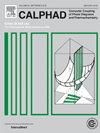Sn-In-Ni-Zn四元体系的相变温度
IF 1.9
3区 材料科学
Q4 CHEMISTRY, PHYSICAL
Calphad-computer Coupling of Phase Diagrams and Thermochemistry
Pub Date : 2025-07-01
DOI:10.1016/j.calphad.2025.102854
引用次数: 0
摘要
Sn-In-Ni-Zn系统是一种重要的电子焊接材料系统。各种合金,如Sn-In, Sn-Ni, Sn-Zn和Sn-In - zn,经常用于电子产品。出乎意料的是,即使对于这些重要的体系,也只有有限的液相线和不变反应温度的实验测量。此外,实验结果与使用各种可用数据库的CALPHAD方法计算的结果存在显着差异。为了解决这些问题,制备了Sn-Zn、Sn-In、Sn-Ni、Sn-In - zn、Sn-Ni - zn、Sn-In - ni和Sn-In - ni - zn等富锡合金。它们的液相温度是通过热分析结合保温淬火实验来测定的,不变反应温度是通过带内标的热分析来测定的。测量的不确定度为液体温度为3℃,不变反应为1℃。尽管高质量的热分析可以以高达1°C的精度确定相变温度,但当热效应不显著时,液相温度的可靠测定变得相当具有挑战性。这也许可以解释为什么文献数据不一致。这些实验结果随后用于改进calphad型建模,并获得了更一致的相图计算。本文章由计算机程序翻译,如有差异,请以英文原文为准。
Phase transformation temperatures of the Sn–In–Ni–Zn quaternary system
The Sn–In–Ni–Zn system is an important material system for electronic soldering. Various alloys, such as Sn–In, Sn–Ni, Sn–Zn, and Sn–In–Zn, are frequently used in electronic products. Unexpectedly, it was found that even for these important systems, there are only limited experimental measurements of the liquidus and invariant reaction temperatures. Additionally, there are significant differences between the experimental results and those calculated using the CALPHAD method with various available databases. To tackle these issues, Sn-rich alloys including Sn–Zn, Sn–In, Sn–Ni, Sn–In–Zn, Sn–Ni–Zn, Sn–In–Ni, and Sn–In–Ni–Zn were prepared. Their liquidus temperatures were determined experimentally through thermal analysis combined with holding-quenching experiments, while invariant reaction temperatures were measured using thermal analysis with an internal marker. The uncertainties in the measurements are 3 °C for the liquidus temperatures and 1 °C for the invariant reactions. Although high-quality thermal analysis can determine phase transformation temperatures with an accuracy of up to 1 °C, reliable determination of liquidus temperatures becomes quite challenging when the heat effect is not significant. This may explain why the literature data are inconsistent. These experimental results were subsequently used to refine CALPHAD-type modeling, and phase diagram calculations with better agreement were achieved.
求助全文
通过发布文献求助,成功后即可免费获取论文全文。
去求助
来源期刊
CiteScore
4.00
自引率
16.70%
发文量
94
审稿时长
2.5 months
期刊介绍:
The design of industrial processes requires reliable thermodynamic data. CALPHAD (Computer Coupling of Phase Diagrams and Thermochemistry) aims to promote computational thermodynamics through development of models to represent thermodynamic properties for various phases which permit prediction of properties of multicomponent systems from those of binary and ternary subsystems, critical assessment of data and their incorporation into self-consistent databases, development of software to optimize and derive thermodynamic parameters and the development and use of databanks for calculations to improve understanding of various industrial and technological processes. This work is disseminated through the CALPHAD journal and its annual conference.

 求助内容:
求助内容: 应助结果提醒方式:
应助结果提醒方式:


